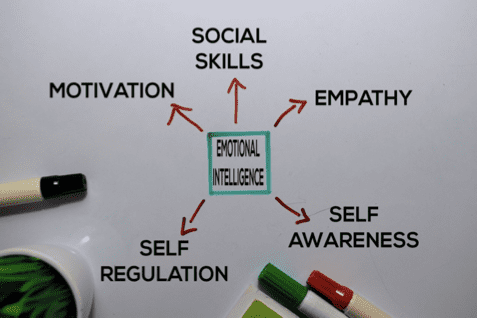Not everyone is born with emotional intelligence. Most people associate intelligence with IQ (intelligence quotient), a number that represents a person’s reasoning ability, measured using problem-solving tests. Emotional intelligence is a series of learned human behaviors that can also be measured.
And some of the science behind it confirms that emotional intelligence is a better indicator of how well a person will succeed in their career. It can also be a measurement of value that can determine whether or not a company is progressing toward business agility.
This blog post is based on Daniel Goleman’s work; he has about 16 books written on the topic. The one that I gravitated to was Working with Emotional Intelligence because it has a framework around the competencies that we can grow. That framework goes deep into self-awareness, self-regulation, motivation, empathy, and social skills. I’ve worked with all of those competencies to help evolve SAFe transformations. Why? Because evolving one’s emotional intelligence is germane to the critical roles, events, and activities that occur. Emotional intelligence competencies affect the human aspect of change, the natural resistance to change, and the ability to inspire everyone around shifts in direction, visions, and ultimately, value.
I personally find the topic fascinating. In the title of Goleman’s book, “Working” is the key word. Emotional intelligence isn’t something we’re born with, and honestly, not everyone chooses to “work” with this type of awareness and the elements that support their growth.
Goleman categorizes five dimensions of emotional intelligence:
Self-awareness
Self-regulation
Motivation
Empathy
Social skills

And those five dimensions fall into two buckets: personal competence, and social competence. He cites each competency that supports them as independent (each makes a unique contribution to your job or life performance), interdependent (each draws to a certain extent upon others, with some strong interactions), and hierarchical (the emotional intelligence competencies build upon each other). Goleman goes on to say that they are all necessary, but not sufficient. In other words, having emotional intelligence does not guarantee that you’ll develop or display competencies such as collaboration or leadership, which are crucial in any SAFe transformation. Other factors such as your organization’s climate or culture or your personal interest in your job, will highly influence how the competencies manifest.
And finally, the dimensions are generic. They all apply to most jobs, yet some jobs will require differing competence demands. For example, you’ll leverage some of them for different career paths within or outside SAFe transformations.
- Product managers, product owners, and architects will mostly likely lean on their motivation and empathy capabilities to share and inspire others through their vision, backlogs, and value to customers.
- Release train engineers will lean on empathy and their social skills to foster healthy, thriving, innovative teams.
- Operations folks will leverage their personal motivation and social skills to reach out to developers and teams to see how they can help and evolve the CALMR side of our DevOps practices.
- And our c-suite of leaders and business owners will absolutely lean on most, if not all, of the competencies. Either way, in respect to those we serve, these competencies all have a long-lasting impact on organizations and humanity as a whole.
Hard Skills, Not Soft Skills
Now, you may not think you care about what some refer to as “soft skills.” The reality is that emotional intelligence represents hard skills and they have a long-lasting impact on how the people around you will ultimately behave and perform. These skills are probably the most difficult to embody because you have to work on yourself, make yourself vulnerable, and be emotionally transparent and available. And you have to show up for those major events with perhaps your highest level of awareness and the associated intelligence on how you handle your emotions. Holding successful events such as PI planning, participatory budgeting, value stream identification workshops, visioning, inspect and adapt, are just some of the critical activities within SAFe that absolutely depend on you working with your emotional intelligence competencies.
Here’s a summary of Goleman’s emotional competencies, and some advice on how you can apply them in your world.
Personal competence
We use self-awareness, self-regulation, and motivation to manage ourselves. And to recognize and understand our moods, emotions, and drives, as well as the effect they have on others. When we’re building our development value streams and designing our ARTs, this is critical.
Self-awareness is knowing yourself, your internal states, your preferences and impulses, your cognitive resources, and your intuitions. Having self-awareness allows us to show up with humility and vulnerability around who we are and how we behave. This competency directly impacts our culture and how we learn together.
Self-regulation builds upon self-awareness. It teaches you how to regulate and manage your internal states and your impulses. Being able to self-regulate enables you to control or redirect disruptive impulses and moods—and to suspend judgment so that you think before you act. Self-regulation requires you, as a leader, to take time for yourself, recharge your batteries, reflect, and learn how you can improve. Self-regulation impacts SAFe implementations in many ways. Imagine you’re in that meeting where the in-house “un-self-aware” leader shows up with their own agenda and aggressively promotes their views—without listening, self-regulating, or empathizing with others. The result? Attendees shut down, feel disengaged, unheard, and even worse, not valued as humans. Now, imagine you’re in the same meeting where your most evolved, self-aware, and self-regulated leader shows up. This leader listens, empathizes, self-regulates their opinions, and engages the views inclusive of the entire group. People feel heard, appreciated, and excited to be a part of something. Which meeting do you think will have better outcomes?
Motivation includes the emotional tendencies that guide or facilitate us in reaching our goals. Motivation embodies a passion to work for reasons that go beyond money or status. This is our inner drive to pursue goals with energy and persistence. What motivates us to pursue a hobby or to give back? And how do we show up, lead, and inspire with motivation? Motivation directly impacts how we get behind a vision and mission, and invest our passions and emotions into delivering value to our customers.
Social competence
I mentioned that personal competence, the first area of emotional intelligence, is a foundation or prerequisite for social competence. That’s because self-awareness is critical to be empathetic and grow the social skills required to scale. Why is that?
In order to work with emotional intelligence and grow our personal competence, we need to know ourselves intimately and be self-aware of our own behaviors. Once we develop that human agency, which includes self-awareness, self-regulation, and motivation within ourselves, we open up our personal aperture to model this behavior. And to help others and our organization authentically fuel and support that second operating system. That second operating system encompasses our social networks, our development value streams, and our Agile Release Trains (ARTs). Our development value streams are our people, aligned to a common goal or mission of delivering value to our customers.
Knowing yourself fuels the social competence dimensions of empathy and social skills.
These determine how we handle relationships. And in our SAFe enterprises, our social networks and social competence, and the development value streams in which they live, are critical for delivering value and the economics that fuel our enterprise mission. These competencies foster communication, knowledge transfer, and information coherence, which attempts to describe how much information in the current state of communication will remain after the state goes through the channel. The channel includes your teams, your ARTs, your developers, and ultimately, your business partners and customers. All are critical to delivering value to customers.
The first element within the social competence dimension is empathy. This is the ability to understand and share the feelings of others. It’s the awareness of others’ needs, concerns, pains, and what it is they want to gain.
From a scaling Agile and business agility perspective, social skills competencies are probably most important because they shape proficiency in inducing desirable responses in others.
They are deep and include adeptness in influence, communication, conflict management, leadership, initiating or managing change, building bonds, and collaboration. They also create group synergy in our teams’ capabilities. Think about it. Aren’t these all learned behaviors that we encounter every day in our SAFe transformations?
The premise of this blog post is that emotional intelligence has an unparalleled value that can be measured. But how? Emotional intelligence seems like a personal journey. But if we know this is important personally, then it has to have an impact at scale. And when we look at SAFe measurements of flow, outcomes, and competencies, they seem logical to measure from an emotional competence perspective as well. After all, we measure all the other competencies, why not emotional intelligence?
Learn More
If you attended the Global SAFe Summit but didn’t catch my talk about emotional intelligence, watch it on-demand here. Read Daniel Goleman’s book Working with Emotional Intelligence to evolve your emotional intelligence journey.
In the next post in my blog series, I’ll discuss how the emotional intelligence competencies, directly and indirectly, impact SAFe’s Business Agility Value Stream. And how you can leverage them for better results from a flow and outcomes perspective.
About Jennifer Fawcett

Jennifer is a retired, empathetic Lean and Agile leader, practitioner, coach, speaker, and consultant. A SAFe Fellow, she has contributed to and helped develop SAFe content and courseware. Her passion and focus have been in delivering value in the workplace and by creating communities and culture through effective product management, product ownership, executive portfolio coaching, and leadership. She has provided dedicated service in these areas to technology companies for over 35 years. Connect with Jennifer on LinkedIn.
Share:
Back to: All Blog Posts
Next: Aligning Global Teams Through Agile Program Management: A Case Study